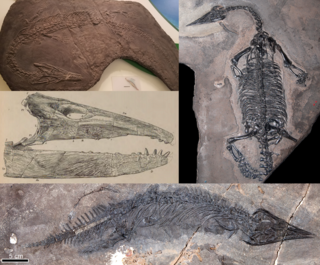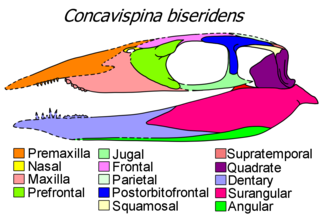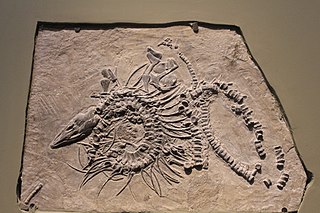
The Triassic is a geologic period and system which spans 50.5 million years from the end of the Permian Period 251.902 million years ago (Mya), to the beginning of the Jurassic Period 201.4 Mya. The Triassic is the first and shortest period of the Mesozoic Era. Both the start and end of the period are marked by major extinction events. The Triassic Period is subdivided into three epochs: Early Triassic, Middle Triassic and Late Triassic.

Archosauromorpha is a clade of diapsid reptiles containing all reptiles more closely related to archosaurs rather than lepidosaurs. Archosauromorphs first appeared during the late Middle Permian or Late Permian, though they became much more common and diverse during the Triassic period.

Drepanosaurs are a group of extinct reptiles that lived between the Carnian and Rhaetian stages of the late Triassic Period, approximately between 230 and 210 million years ago. The various species of drepanosaurid were characterized by specialized grasping limbs and often prehensile tails, adaptions for arboreal (tree-dwelling) and fossorial (digging) lifestyles, with some having also been suggested to be aquatic. Fossils of drepanosaurs have been found in Arizona, New Mexico, New Jersey, Utah, England, and northern Italy. The name is taken from the family's namesake genus Drepanosaurus, which means "sickle lizard," a reference to their strongly curved claws.

Thalattosauria is an extinct order of prehistoric marine reptiles that lived in the Middle to Late Triassic. Thalattosaurs were diverse in size and shape, and are divided into two superfamilies: Askeptosauroidea and Thalattosauroidea. Askeptosauroids were endemic to the Tethys Ocean, their fossils have been found in Europe and China, and they were likely semiaquatic fish eaters with straight snouts and decent terrestrial abilities. Thalattosauroids were more specialized for aquatic life and most had unusual downturned snouts and crushing dentition. Thalattosauroids lived along the coasts of both Panthalassa and the Tethys Ocean, and were most diverse in China and western North America. The largest species of thalattosaurs grew to over 4 meters (13 feet) in length, including a long, flattened tail utilized in underwater propulsion. Although thalattosaurs bore a superficial resemblance to lizards, their exact relationships are unresolved. They are widely accepted as diapsids, but experts have variously placed them on the reptile family tree among Lepidosauromorpha, Archosauromorpha, ichthyosaurs, and/or other marine reptiles.

Miodentosaurus is a genus of thalattosaurian from the Late Triassic of China. It is one of several thalattosaurs found in the Xiaowa Formation, also known as the Wayao Member of the Falang Formation. The genus name "Miodentosaurus" translates to "Few toothed-lizard" while the species name "brevis" means "short", in reference to its short snout.

Thalattosaurus meaning "sea lizard," from the Attic Greek thalatta (θάλαττα), "sea," and sauros (σαῦρος), "lizard," is an extinct genus of marine reptile in the family Thalattosauroidea. They were aquatic diapsids that are known exclusively from the Triassic period. It was a 2–3 metres (6.6–9.8 ft) long shellfish-eating reptile with paddle-like limbs and a down-turned rostrum occurring in the Lower and Middle Triassic Sulphur Mountain Formation of British Columbia as well as the Upper Triassic Hosselkus Limestone of California. It has gained notoriety as a result of studies on general diapsid phylogeny.

Helveticosaurus is an extinct genus of diapsid marine reptile known from the Middle Triassic of southern Switzerland. It contains a single species, Helveticosaurus zollingeri, known from the nearly complete holotype T 4352 collected at Cava Tre Fontane of Monte San Giorgio, an area well known for its rich record of marine life during the Middle Triassic.

Weigeltisauridae is a family of gliding neodiapsid reptiles that lived during the Late Permian, between 259.51 and 251.9 million years ago. Fossils of weigeltisaurids have been found in Madagascar, Germany, Great Britain, and Russia. They are characterized by long, hollow rod-shaped bones extending from the torso that probably supported wing-like membranes. Similar membranes are also found in several other extinct reptiles such as kuehneosaurids and Mecistotrachelos, as well as living gliding lizards, although each group evolved these structures independently.

Askeptosauridae is a family of thalattosaurs within the superfamily Askeptosauroidea. Fossils have been found from Italy, Switzerland, and China. Askeptosaurids are distinguished from other thalattosaurs by their long necks and narrow skulls.

Anshunsaurus is a genus of thalattosaurs within the family Askeptosauridae. Fossils have been found from Middle Triassic deposits in Guizhou, China. Three species are known: the type species A. huangguoshuensis, the slightly older species A. wushaensis, and the species A. huangnihensis.

Thalattosauroidea is a superfamily of thalattosaurs, a Triassic group of marine reptiles. It was named in 1904 by paleontologist John Campbell Merriam to include the genus Thalattosaurus from California. Thalattosauroids are one of two groups of Thalattosauria, the other being Askeptosauroidea. Thalattosauroids make up the "traditional" thalattosaurs with large downturned snouts, short necks, and long, paddle-like tails.

Hanosaurus is an extinct genus of marine reptiles that existed during the Triassic period in what is now China. The type species is Hanosaurus hupehensis. It was a small animal, with specimens measuring 79.4 cm (31.3 in) long in total body length, which likely fed on soft-bodied prey.

Concavispina is an extinct genus of thalattosaur reptile from the early Late Triassic Xiaowa Formation of Guangling, Guizhou, southern China. It contains a single species, Concavispina biseridens. It is known only from the holotype ZMNH M8804, a nearly complete 364 cm long skeleton. Concavispina can be differentiated from other thalattosaurs by possessing two rows of blunt teeth on the anterior part of the maxilla and a V-shaped notch on the dorsal margin of each neural spine in the dorsal (back) vertebrae. Both its generic and specific names refer to these autapomorphies, as Concavispina means "concave spine" and biseridens means "two rows of teeth". It is thought to be most closely related to Xinpusaurus, as both taxa share three derived characters: a maxilla that is curved upward at its anterior end, a humerus that is wider near the shoulder than near the elbow, and the presence of less than five cervicals.

Xinpusaurus is an extinct genus of thalattosaur from the Late Triassic of Guanling in Guizhou, China. Several species have been named since 2000: the type species X. suni along with the species X. bamaolinensis and X. kohi. A 2013 study proposed that all three species are synonymous with each other, in which case X. suni would be the only valid species, although a 2014 study argued that X. kohi was also valid. A fourth species, X. xingyiensis, was described in 2016.

Blezingeria is an extinct genus of marine reptile from the Middle Triassic of Germany. The type and only species Blezingeria ichthyospondyla was named by German paleontologist Eberhard Fraas in 1896. It is known from many isolated bones that come from a deposit in southwestern Germany called the Upper Muschelkalk, which dates back to the Ladinian stage. The relationships of Blezingeria are uncertain. Fraas identified it as a nothosaur, but it has also been classified as a cymbospondylid ichthyosaur, and most recently a thalattosaur. Many thalattosaur fossils have been found in a slightly olderLate Ladinian-age rock unit in Monte San Giorgio, Switzerland, so if Blezingeria is a thalattosaur, it may represent an early stage in an evolutionary radiation of the group across the Tethys, an ocean that covered much of what is now Europe and southern China during the Triassic. However, since Blezingeria is known from very incomplete material, its classification as a thalattosaur remains uncertain.
The Sulphur Mountain Formation is a geologic formation of Early to Middle Triassic age. It is present on the western edge of the Western Canada Sedimentary Basin in the foothills and Rocky Mountains of western Alberta and northeastern British Columbia. It includes marine fossils from the time shortly after the Permian-Triassic extinction event.
Elizabeth (Betsy) Laura Nicholls was an American-Canadian paleontologist who specialized in Triassic marine reptiles. She was a paleontologist at the Royal Tyrrell Museum in Alberta, Canada.
Agkistrognathus is an extinct genus of thalattosaurian which lived in the early to middle Triassic of British Columbia, Canada. There is only one species known in this genus, Agkistrognathus campbelli. The genus name translates to "hook jaw" while the species name refers to Bob Campbell, who discovered the only known specimen.
Gunakadeit is an extinct genus of thalattosaur. It is known from a single species, Gunakadeit joseeae, which is based on an articulated and mostly complete skeleton from the late Triassic Hound Island Volcanics of Alaska. Gunakadeit possessed a variety of features from the two major suborders of thalattosaurs, Askeptosauroidea and Thalattosauroidea, and it is considered the most basal member of the latter group. Despite this, it is also the youngest known thalattosaur genus, with the group going extinct at the end of the Triassic. Gunakadeit's basal position and relatively recent occurrence implies a 20-million-year ghost lineage connecting it to the rest of Thalattosauria. The skull ends in a sharply pointed and toothless tip like the askeptosauroid Endennasaurus, but unlike Endennasaurus, Gunakadeit had poorly developed joints and was likely exclusively aquatic in behavior.
This list of fossil reptiles described in 2023 is a list of new taxa of fossil reptiles that were described during the year 2023, as well as other significant discoveries and events related to reptile paleontology that occurred in 2023.














